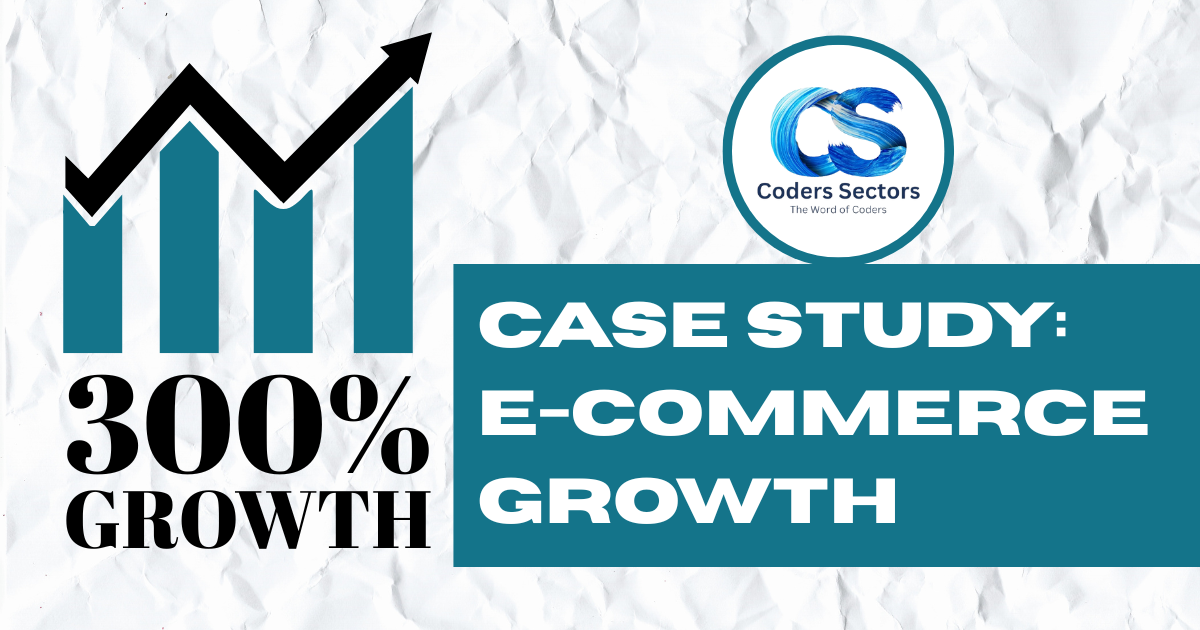Case Study: How We Helped an E-commerce Store Grow 300% with Web & SEO Solutions

In today’s fast-paced digital marketplace, simply having a website is no longer enough. Businesses need a platform that is fast, user-friendly, and optimized for search engines to attract visitors and convert them into paying customers. At Coders Sectors, we recently partnered with a growing e-commerce brand in Maharashtra that specialized in fashion and lifestyle products. Despite having a website, the client faced major challenges, including very low organic traffic, poor website speed, a non-mobile-friendly design, absence of SEO strategy, and high bounce rates. Their main objective was to increase online sales and establish a stronger presence in the digital space.
When our team conducted a comprehensive audit, we discovered several critical issues that were limiting growth. The website had an outdated design that did not reflect the brand’s identity and a complicated navigation structure that frustrated users. Secure payment gateways were missing, and product display and filtering options were limited. From an SEO perspective, there was no keyword optimization, missing meta titles, descriptions, and image alt texts, a zero backlink profile, and slow page loading times exceeding five seconds. Marketing gaps included the lack of lead tracking, weak call-to-actions (CTAs), and no local SEO optimization.
To address these issues, we implemented a complete growth strategy combining web development, technical SEO, on-page and off-page optimization, and conversion improvements. First, we redesigned the website with a mobile-first, responsive approach to ensure seamless access for all users. Navigation was simplified, and we integrated secure payment gateways like Razorpay, PayPal, and UPI. Features such as wishlists, product filters, and quick checkout options were added to enhance user experience.
Technical SEO improvements included optimizing page speed from over five seconds to under two seconds, implementing structured data/schema markup for all products, fixing crawl errors, updating the XML sitemap, and optimizing the robots.txt file. On-page SEO focused on conducting in-depth keyword research and optimizing product titles, descriptions, and images. We also created SEO-rich blog content targeting high-converting long-tail keywords, such as “buy fashion products online in India,” “affordable lifestyle e-commerce store,” and “best online shopping platform in Maharashtra.”
Off-page SEO efforts included building high-quality dofollow backlinks from trusted e-commerce directories, guest blogging sites, and business listing platforms, which increased the Domain Authority (DA) from 10 → 35 within four months. Conversion optimization strategies were also implemented, including the addition of strong CTAs like “Shop Now,” “Limited Time Offer,” and “Free Delivery,” as well as exit-intent popups with special discounts. A/B testing was conducted on product pages to further improve engagement and sales.
The results of these combined efforts were remarkable. Within six months, the client experienced a 300% increase in sales, and organic traffic grew from 500 → 4,500 monthly visitors. The bounce rate was reduced from 70% to 35%, and the average order value increased by 40%. Additionally, the website began ranking on Google’s first page for multiple high-value keywords, including “fashion e-commerce store in Maharashtra,” “affordable lifestyle products online India,” and “buy clothes online in Nagpur.”
The client shared their feedback:
“Working with Coders Sectors transformed our business. The new website is fast, professional, and user-friendly. Within months, we saw massive traffic and sales growth. Highly recommended!”
This case study demonstrates several key takeaways for businesses seeking growth online. A modern, optimized website is essential for e-commerce success, while SEO serves as a primary driver of organic sales. Continuous monitoring and optimization are critical for long-term results, and combining web development, SEO, and conversion strategies ensures maximum ROI.
At Coders Sectors, we specialize in e-commerce website development, custom software solutions, SEO for online stores, and digital marketing services designed to increase traffic, generate leads, and grow businesses. If you are a business owner looking to increase online sales, our team can help you achieve similar results.
📞 Contact Us Today for a Free Consultation:
🌐 www.coderssectors.com
📧 info@coderssectors.com

